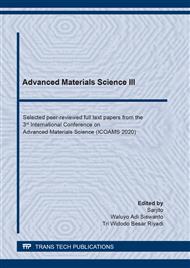[1]
Wang XY, Luan Y. Modeling of Hydration, Strength Development, and Optimum Combinations of Cement-Slag-Limestone Ternary Concrete. International Journal of Concrete Structures and Materials 12 (2018) 1-13.
DOI: 10.1186/s40069-018-0241-z
Google Scholar
[2]
Wang XY. Impact of Climate Change on Proportional Design of Fly‑Ash‑Blended Low‑CO2 Concrete. ACI Materials Journal 116(2019) 141-151.
DOI: 10.14359/51714465
Google Scholar
[3]
Sobhani J, Najimi M, Pourkhorshidi AR, Parhizkar T. Prediction of the compressive strength of no-slump concrete: A comparative study of regression, neural network and ANFIS models. Construction and Building Materials 24 (2010) 709-718.
DOI: 10.1016/j.conbuildmat.2009.10.037
Google Scholar
[4]
Yuan Z, Wang LN, Ji X. Prediction of concrete compressive strength: Research on hybrid models genetic based algorithms and ANFIS. Advances in Engineering Software 67 (2014) 156-163.
DOI: 10.1016/j.advengsoft.2013.09.004
Google Scholar
[5]
Sadrmomtazi A, Sobhani J, Mirgozar MA. Modeling compressive strength of EPS lightweight concrete using regression, neural network and ANFIS. Construction and Building Materials 42 (2013) 205-216.
DOI: 10.1016/j.conbuildmat.2013.01.016
Google Scholar
[6]
Nedushan BA. Prediction of elastic modulus of normal and high strength concrete using ANFIS and optimal nonlinear regression models. Construction and Building Materials 36 (2012) 665-673.
DOI: 10.1016/j.conbuildmat.2012.06.002
Google Scholar
[7]
Boga AR, Ozturk M, Topçu IB. Using ANN and ANFIS to predict the mechanical and chloride permeability properties of concrete containing GGBFS and CNI. Composites: Part B 45 (2013) 688-696.
DOI: 10.1016/j.compositesb.2012.05.054
Google Scholar
[8]
Amani J, Moeini R. Prediction of shear strength of reinforced concrete beams using adaptive neuro-fuzzy inference system and artificial neural network. Scientia Iranica A 19(2012), 242–248.
DOI: 10.1016/j.scient.2012.02.009
Google Scholar
[9]
Nazari A, Khalaj G, Riahi S. ANFIS-based prediction of the compressive strength of geopolymers with seeded fly ash and rice husk–bark ash. Neural Comput & Applic 22(2013) 689–701.
DOI: 10.1007/s00521-011-0751-y
Google Scholar
[10]
Lam L, Wong YL, Poon CS. Effect of fly ash and silica fume on compressive and fracture behaviors of concrete. Cement and Concrete Research 28(1998) 271–283.
DOI: 10.1016/s0008-8846(97)00269-x
Google Scholar
[11]
www.mathworks.com.
Google Scholar
[12]
Z. Mo, X. Gao and A. Su, Mechanical performances and microstructures of metakaolin contained UHPC matrix under steam curing conditions, Construction and Building Materials, https://doi.org/10.1016/j.conbuildmat.2020.121112.
DOI: 10.1016/j.conbuildmat.2020.121112
Google Scholar
[13]
Ling Qin, Xiaojian Gao, Anshuang Su, QiyanLi. Effect of carbonation curing on sulfate resistance of cement-coal gangue paste. Journal of Cleaner Production 278(2021)123897.
DOI: 10.1016/j.jclepro.2020.123897
Google Scholar


